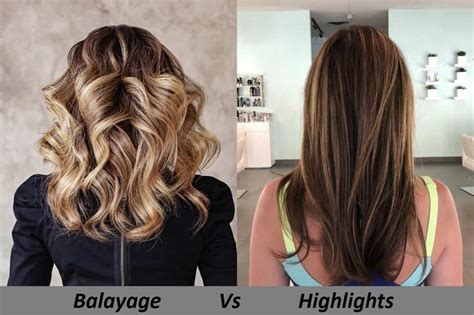Introduction

In the realm of hair artistry, balayage and highlights reign supreme, offering clients a captivating canvas to express their individuality. These techniques enhance locks with a subtle yet alluring effect, creating a multifaceted play of light and dimension.
Balayage vs Highlights: Key Differences
1. Application Method:
- Balayage: A freehand technique that uses a sweeping motion to apply lightener to the surface of the hair, mimicking natural sun-kissed strands.
- Highlights: A sectioning and foiling technique that isolates strands and lifts their color to create defined streaks or panels.
2. Result:
- Balayage: Delivers a gradual, seamless transition of color from root to tip. It results in a soft, blended look with minimal visible lines of demarcation.
- Highlights: Creates bolder, more striking panels of color. The transitions between highlighted and non-highlighted areas are more noticeable.
3. Maintenance:
- Balayage: Requires less frequent touch-ups (every 4-6 months) as the regrowth is less obvious.
- Highlights: Needs more frequent touch-ups (every 2-3 months) to maintain the contrast between highlighted and non-highlighted strands.
4. Cost:
- Balayage: Generally more expensive than highlights due to its time-consuming nature.
- Highlights: Less expensive than balayage, especially for shorter hair.
Benefits of Balayage:
- Natural-Looking: Mimics the sun-kissed effects of natural hair, resulting in a lived-in, effortless look.
- Customizable: Allows for precise placement of color to enhance specific facial features or create a desired silhouette.
- Low Maintenance: Requires less frequent touch-ups, saving time and money.
- Versatile: Suited for all hair types and textures, adding dimension and movement to both straight and curly locks.
Benefits of Highlights:
- Bold Transformation: Creates a more dramatic and eye-catching color change.
- Precision: Delivers defined streaks or panels of color, allowing for greater control over the overall look.
- Corrective: Can be used to fix uneven color or cover up unwanted tones.
- Frames the Face: When placed strategically, highlights can brighten the complexion and enhance facial features.
Table 1: Balayage vs Highlights at a Glance
| Feature | Balayage | Highlights |
|---|---|---|
| Application Method | Freehand sweeping | Sectioning and foiling |
| Result | Seamless transition, soft blend | Bolder panels, striking contrast |
| Maintenance | Less frequent touch-ups | More frequent touch-ups |
| Cost | More expensive | Less expensive |
Table 2: When to Choose Balayage or Highlights
| Hair Type/Goal | Balayage | Highlights |
|---|---|---|
| For a natural, sun-kissed look | Yes | No |
| For bold, defined color panels | No | Yes |
| For low-maintenance, easy regrowth | Yes | No |
| For adding dimension and movement | Yes | Yes |
Tips and Tricks:
- Consider your skin tone and eye color when choosing a balayage or highlight shade.
- Communicate your desired look clearly to your stylist to ensure the best results.
- Use color-protecting products to preserve the vibrancy of your hair.
- Get regular trims to remove split ends and maintain the overall health of your hair.
How to Choose a Colorist:
- Look for a stylist with experience in your desired technique.
- Check online reviews and portfolios to find a reputable and skilled professional.
- Consult with multiple stylists to find one who understands your vision and matches your hair goals.
Conclusion:
Whether you prefer the subtle allure of balayage or the bold contrast of highlights, both techniques offer transformative power to elevate your hair game. Understanding their key differences and benefits will empower you to make an informed decision that complements your unique style and personality. Embrace the endless possibilities of hair artistry and let your locks shine their brightest.
